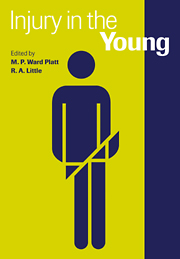Book contents
- Frontmatter
- Contents
- List of contributors
- Editors' Preface
- 1 The epidemiology of trauma involving children
- 2 Emergency room requirements for children
- 3 Child deaths in Accident and Emergency
- 4 Immediate life support
- 5 Evaluation of injury in children
- 6 Injuries of the developing brain
- 7 Wound healing in children
- 8 The lung after injury in children
- 9 Metabolic and endocrine stress responses to surgery
- 10 Head injury in children
- 11 Near drowning
- 12 The acute response to burn injury in children
- 13 Nutritional support of the severely burned child
- 14 Recovery, rehabilitation and the neuropsychological sequelae of head injury
- 15 Children's rights and child protection
- Index
3 - Child deaths in Accident and Emergency
Published online by Cambridge University Press: 18 September 2009
- Frontmatter
- Contents
- List of contributors
- Editors' Preface
- 1 The epidemiology of trauma involving children
- 2 Emergency room requirements for children
- 3 Child deaths in Accident and Emergency
- 4 Immediate life support
- 5 Evaluation of injury in children
- 6 Injuries of the developing brain
- 7 Wound healing in children
- 8 The lung after injury in children
- 9 Metabolic and endocrine stress responses to surgery
- 10 Head injury in children
- 11 Near drowning
- 12 The acute response to burn injury in children
- 13 Nutritional support of the severely burned child
- 14 Recovery, rehabilitation and the neuropsychological sequelae of head injury
- 15 Children's rights and child protection
- Index
Summary
Introduction
Beginning to deal with the death of a child, particularly after the body has been traumatised, can be overwhelming both for parents and carers. In recent years, more has been written about this catastrophic experience from the parents', siblings' and family's viewpoint. Much less is written about the trauma team's experience. Ahmedzai (1982) highlighted how doctors in training are unsupported and ‘out on a limb’, and how they are neglected by consultants when caring for dying patients.
This chapter will review work on caring for everyone involved in the death of a child, particularly when this is sudden and traumatic.
You may ask why we need actively to intervene at all. For thousands of years the human race has dealt with death. Bereavement is listed in the Holmes and Rahe Social Readjustment Rating Scale (1967) as the most stressful life event. The significance of the loss of a child produces the strongest pain (Sanders, 1980) and the most widespread reactions. Raphael (1985: 229) focused on the reason for this:
a child is many things: a part of the self, and of the loved partner; a representation of the generations past; the genes of the forebears; the hope of the future; a source of love, pleasure, even narcissistic delight; a tie or a burden; and sometimes a symbol of the worst parts of self and others.
- Type
- Chapter
- Information
- Injury in the Young , pp. 20 - 30Publisher: Cambridge University PressPrint publication year: 1998



